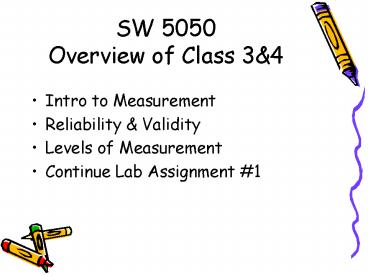SW 5050 Overview of Class 3 - PowerPoint PPT Presentation
1 / 28
Title:
SW 5050 Overview of Class 3
Description:
Assessment of logical relationship between the concept and the proposed measure. ... Involves relating a measure to an overall theoretical framework. ... – PowerPoint PPT presentation
Number of Views:20
Avg rating:3.0/5.0
Title: SW 5050 Overview of Class 3
1
SW 5050Overview of Class 34
- Intro to Measurement
- Reliability Validity
- Levels of Measurement
- Continue Lab Assignment 1
2
Measurement Defined
- Measurement is the process of describing abstract
concepts in terms of real world indicators by the
assignment of numbers or symbols according to
rules.
3
Measurement
- Measurement is essentially the process of
operationalizing concepts. - It involves moving from concepts to variables.
4
Reductionism
- THEORY
- CONCEPTS
- HYPOTHESIS
- VARIABLES
5
Real World Indicators
- An indicator is an observation that is assumed to
be evidence of the attributes or properties of
some phenomenon. - The more abstract a concept, the more indicators
that are necessary to operationally define the
concept into a variable.
6
Item vs. Index
- Item A single indicator of a variable.
- Index A series or number of items needed to
operationalize a variable.
7
Example Complex Concept
- Depression An emotional condition characterized
by decrease in functional activity (nominal
definition). - Indicators
- Excessive Sleeping
- Crying
- Loss of weight
- Loss of appetite
8
Example Complex Concept
- Alcohol Dependence
- Number of drinks per day.
- Time missed from work.
- Daily activities involving alcohol consumption.
- Number of DUIs.
9
Reliability and Validity
- are really about determining whether our real
world indicators capture the complex concept we
are trying to measure.
10
RELIABILITY
- Refers to the consistency of the measure.
- If I measure over and over, will I get the same
results?
11
VALIDITY
- The accuracy of the measure.
- Am I measuring what I think I am measuring?
- Not to be confused with internal or external
validity.
12
RELIABILITY The Inside Story
- If I measure over and over, will I get the same
results? - Applies to both complex and non-complex
variables. (Attendance?) - Two Principles
- Stability and Equivalency.
13
Establishing Stability Equivalency
14
TEST-RETEST
- Most commonly used method.
- Application of instrument at two points in time.
- Two week interval recommended.
- Scores generated from two tests should be
comparable (correlated). - Correlation of .70-.80 necessary.
15
PARALLEL FORMS
- Two separate but equal (parallel) instruments are
developed. - Instruments are combined and administered jointly
to the same group. - Results are correlated. (.70-80)
- Feasibility?
16
SPLIT-HALF
- Best approach for addressing equivalency.
- Responses randomly divided into congruent halves.
- Scores from each half are totaled and correlated.
- Cronbach Alpha
17
ValidityThe Inside Story
- Golden Rule You cannot have validity without
reliability. You can have reliability without
validity. - The ultimate validity of a measure can never be
proven.
- Types of Validity Tests
- Content Validity
- Criterion Validity
- Construct Validity
18
CONTENT VALIDITY
- A.K.A. Face Validity
- Assessment of logical relationship between the
concept and the proposed measure. - Weakest form of validity.
- Expert participation Bolstering face validity.
19
CRITERION VALIDITY
- Show a correlation between our measurement device
and some other criterion. - Key Find solid criterion for purpose of
comparision.
- Two Types
- Concurrent Validity
- Predictive Validity
20
CONCURRENT VALIDITY
- Most common approach.
- Comparison to existing (well established)
instrument. - Minimum correlation of .50 is needed for
establishing concurrent validity.
21
Predictive Validity
- An instrument is used to predict some future
state of affairs or future event. - Quality of the measure (its validity) is
determined by how well it predicts the event. - SAT/GRE??
22
CONSTRUCT VALIDITY
- Most complex form of validity.
- Involves relating a measure to an overall
theoretical framework. - Domains underpinning the complex concept must
be clearly delineated.
23
Additional Issues
- Use of existing instruments.
- Reliable and Valid for whom?
- Creation of instrument??
24
Level of Measurement
- Nominal
- Ordinal
- Interval
- Ratio
25
Nominal Level Variables
- Observations classified into mutually exclusive
categories of kind or type. - Examples
- Gender 1) Female 2) Male
- Ethnicity 1) Anglo 2) African American 3)
Latino 4) Asian American - Political Affiliation 1) Republican
2) Democrat 3) Independent
26
Ordinal Level Variables
- Mutually exclusive categories of kind or type.
- Rank-ordered/hierarchy.
- Examples
- SES 1) Upper 2) Middle 3) Lower
- Education 1) College 2) Secondary 3)
Primary
27
Interval Level Variables
- Mutually Exclusive Categories
- Rank Order/Hierarchy
- Equal Spacing Between Categories
- Examples
- Temperature
- IQ
- Likert Scale
28
Ratio Level Variables
- Mutually Exclusive Categories
- Rank Order
- Equal Spacing
- True Zero
- Example
- Income total monthly salary































